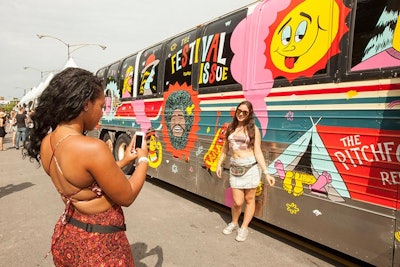
The Pitchfork Review placed a colorful bus—which is on the cover of its latest issue—on festival grounds. Guests were encouraged to "Gram the Bus" (i.e. snap Instagram photos of it) for a chance to win V.I.P. passes to next year's fest or a subscription to the music magazine.
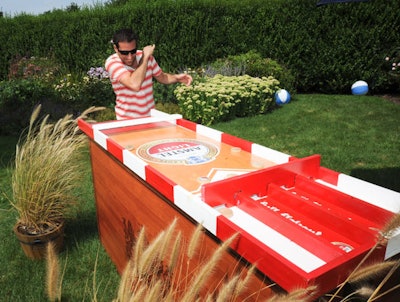
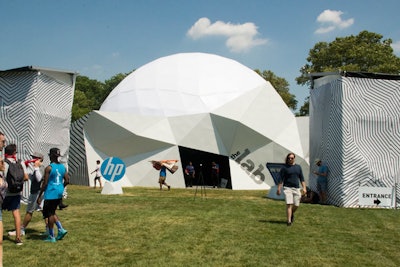
The Lab, which was presented by the Verge and Hewlett-Packard, was the focal point of the festival. Designed and curated by Meta.is, the structure housed seven interactive digital art exhibits.
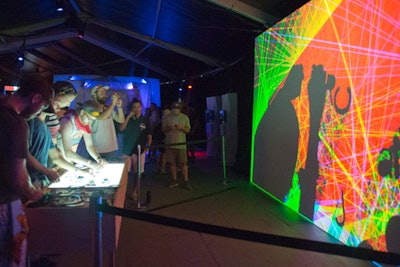
Brooklyn-based artist Zach Lieberman's Reflection Study exhibit allowed guests to create different formations projected onto a wall by moving shapes made out of plexiglass over a light box.
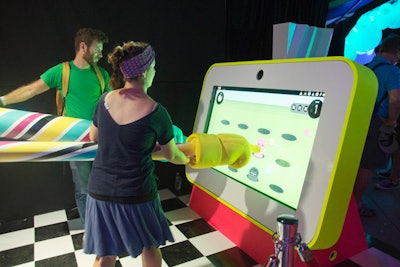
Giant Gestures, an exhibit from Brooklyn art duo Mountain Gods, offered festivalgoers a chance to play around with an oversize touch screen tablet by using giant foam hand props. The installation was meant to reinterpret how humans interact with technology.
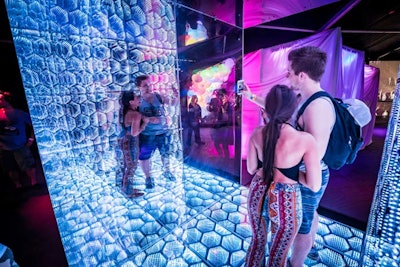
A popular exhibit inside the Lab was the Infinite Wall created by Brooklyn-based artist Gabriel Pulecio. The interactive tunnel—created with mirrors, sounds, and lights—used motion sensors that responded to the guests who stepped inside.

Attendees could physically interact with Hyper Thread, a silk tent that featured seven silk hammocks. Created by Dave Rife and Gabe Liberti, the exhibit enabled festivalgoers to make new sounds by moving around in the hammocks.
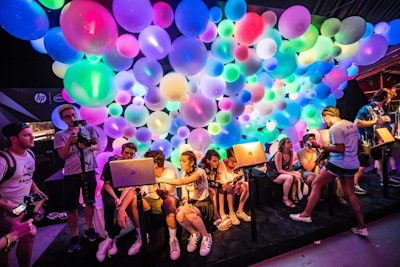
Sponsor HP showcased an attendee-powered color wall inside the Lab. Using the brand's technology, the wall would change colors in time for a selfie taken with a laptop. The activation was produced by Infinity Marketing Team.
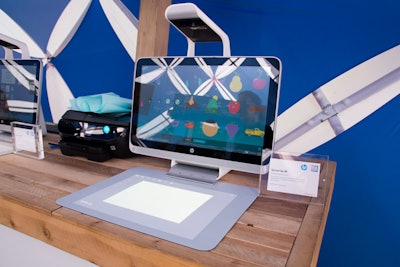
HP also showed off its technology in a separate lounge. The activation gave guests the chance to create custom temporary tattoos using Sprout by HP technology.
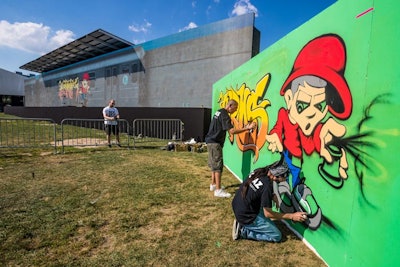
A collaboration between 5Pointz Aerosol Art Center, Mevent, and AST Studios, the subway-train projection paid homage to graffiti art's New York origins. Artists spray-painted graffiti on a green screen, which was translated onto the high-definition video wall.
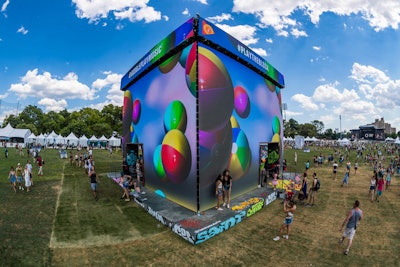
The visually striking, LED-powered multimedia block featured changing videos of animated designs, music videos, and performances, based on fan interaction and festival sets. The structure featured Google Play's social media handle and hashtag.
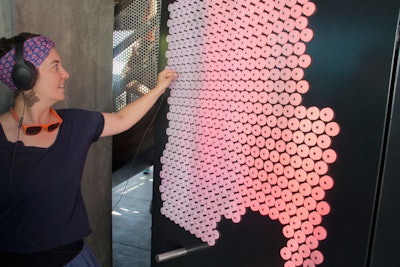
The interior of the block featured a headphone jack wall. Attendees could plug headphones into the various jacks to listen to different songs from Google Play Music playlists, including one curated for the festival. If listeners hit a "winning" jack, they were taken up to the second-story roof to enjoy the festival view.
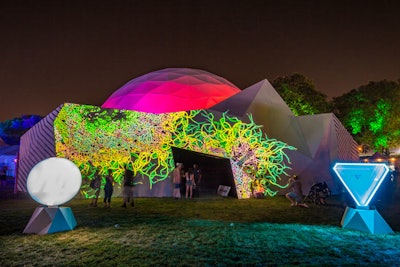
At night, the structure's facade, which was produced by VolvoxLabs, lit up with colorful, projection-mapped ultra-high-definition videos of designs that continuously changed.
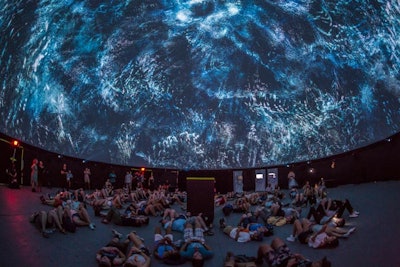
Inside the 70-foot dome was a 360-degree virtual reality theater that held as many as 400 people. The experience was visually produced by Invisible Light Network and Dirt Empire, and Antfood provided sound effects.
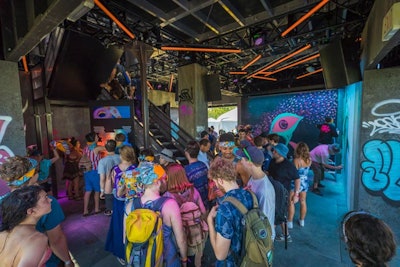
The block also featured live graffiti demonstrations.
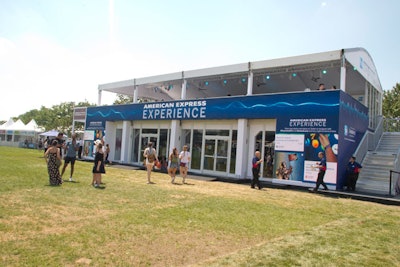
American Express' two-story tent, built and designed by Momentum Worldwide, offered a mix of low-tech and high-tech experiences, including a 360-degree panoramic digital photo booth. The roof deck was open to card members and offered a view of the main stage, DJ sets, and custom cocktails.
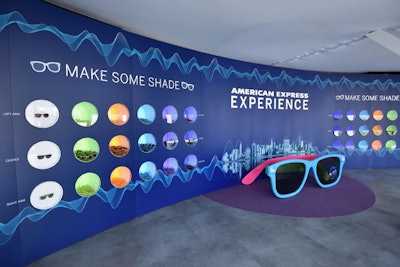
A popular low-tech experience for festivalgoers was a customizable sunglasses station, located on the first and second floors.
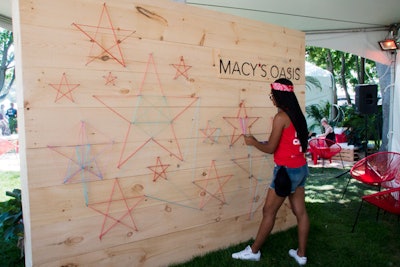
Macy's partnered with LeadDog Marketing Group to produce the Macy's Oasis, which gave festivalgoers a chance to relax with lounge furniture and a charging station. Along with bandanas soaked in ice water, the lounge had a string art wall created by attendees.
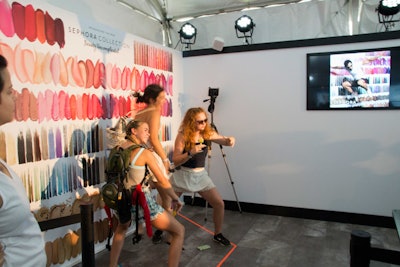
The official beauty sponsor of the festival, Sephora partnered with Revolution Marketing to host a tent that gave festivalgoers a chance to test out a variety of products, including face masks and lip balms. Along with a beauty bar, braid bar, and dry shampoo styling station, the tent had a photo booth with makeup props and a makeup palette backdrop.

Antioxidant infusion beverage brand Bai partnered with Relevant to produce the the lounge, which offered drinks and cocktails, a phone-charging station, and a photo station featuring a LightBright wall created with Bai bottles. Bai also had a custom Snapchat geofilter for the festival.
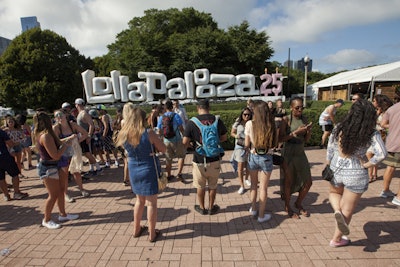
Lollapalooza celebrated its 25th anniversary this year. The milestone was marked in special signage that featured a pink 25 topped with birthday candles.
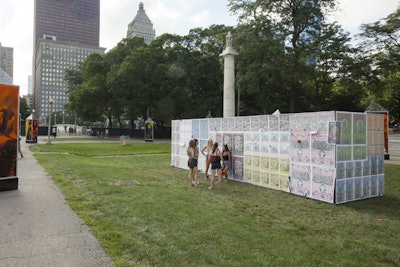
The Lolla Time Warp was another area that nodded to the anniversary. The area showcased vintage festival posters, as well as monuments to legendary artists that have performed there in the past. This year, the 170 acts included Radiohead and Jane's Addiction.
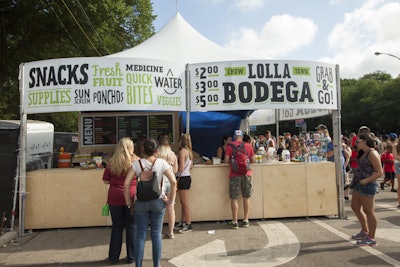
Since the festival had an extra day this year, organizers aimed to keep guests as comfortable as possible. At a new bodega, they could stock up on essentials one may find at a corner store, such as trail mix and sunscreen.
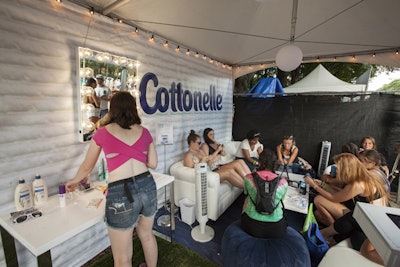
Speaking of festival essentials, Cottonelle doled out free toilet paper. The brand also hosted a "Refresh Lounge" where visitors could find shade, Wi-Fi, charging stations for their phones, and grooming products such as deodorant. There was also a booth where festivalgoers could create GIFs using the hashtag #RocktheRipple. The "ripple" referred to the texture of Cottonelle's toilet tissue.
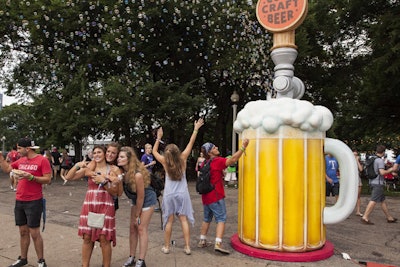
A craft beer lounge known as "Da Beers" was back this year, but with added features. For example, a new 80-foot wall of taps poured Stella Artois, Goose Island, and more.
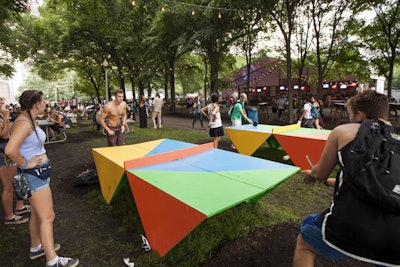
Da Beers expanded this year to include games. In one area, guests played ping-pong at colorful tables.
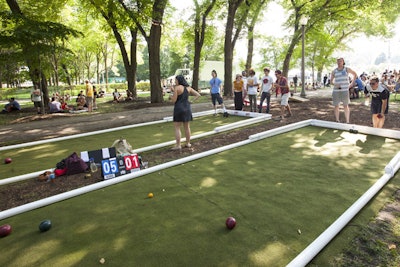
Other games at Da Beers included bocce (pictured), provided by American Bocce Company, as well as corn hole. Along with an expanded beer selection, the festival offered the new "Mix'd Craft Cocktail Bar." The specialty bar served cocktails from brands such as Hendrick's Gin and Tito's Vodka.
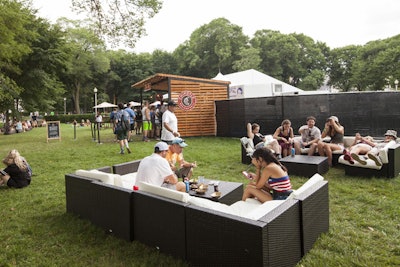
The Mexican chain restaurant set up a pop-up shop on festival grounds. In a nearby lounge area, guests could sit on pillowed couches and snack on tacos.
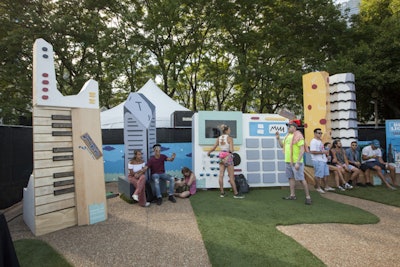
Guests could also find seating—and shade—at Bud Light's activation. The beer brand sold commemorative cans at this year's festival, and partnered with local artist Floyd Davis from Arpentry to create wooden sculptures inspired by the design on the cans. The sculptures featured the city skyline and oversize, functional musical instruments.
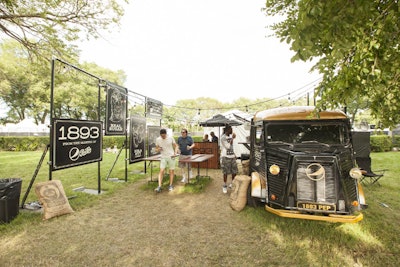
For guests who wanted soft drinks, Pepsi hosted the 1893 tasting truck. The truck was stationed near a light-strung area that looked like a beer garden, and the soft drink was available in cola and ginger flavors. Attendees could also find snacks and drinks at the "Chow Town" area, which featured bites from local restaurants and was again curated by Chicago-based chef Graham Elliot. There were also plenty of Camelback "hydration stations" throughout the park, where guests could access free, filtered water.
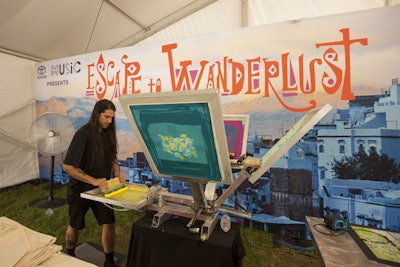
Swag also had a practical purpose this year. Returning sponsor Toyota offered free silk-screened backpacks, which guests used to stow water, sunscreen, and other goods.
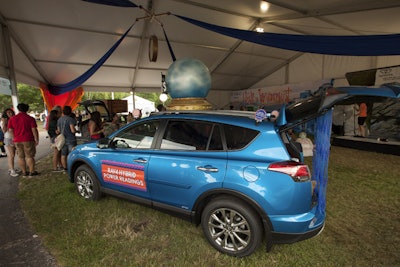
The brand also offered tarot-card readings in one of its its hybrid cars.
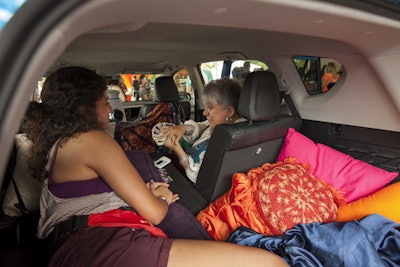
Guests entered the Rav4 hybrid through a beaded curtain in back, then lay on a pile of pillows while a tarot-card reader predicted the future.
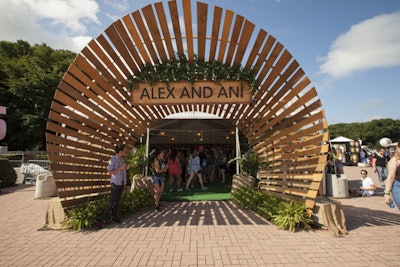
Alex and Ani, an eco-friendly jewelry line, was another sponsor this year.
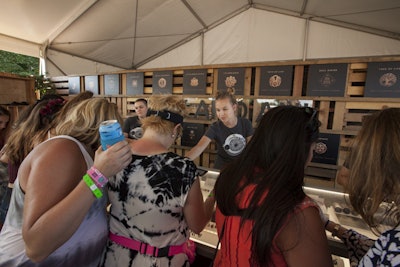
The brand created a commemorative bangle to mark the festival's 25th anniversary; it also offered a variety of styles that guests could purchase on site.
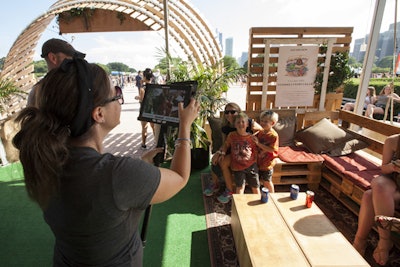
Seating—and shade—can be hard to come by in Grant Park during Lollapalooza. So, Alex and Ani offered a plush seating area near its retail activation.

Visitors could score free, silk-screened bandanas after submitting some personal information and taking a brief survey. The survey helped guests identify their "energy symbol" from a selection that included the Tree of Life and the Phoenix; those energy symbols were then silk-screened onto the bandanas.
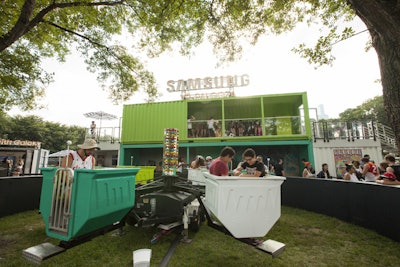
Samsung is the first virtual-reality sponsor of Lollapalooza. To showcase its devices on festival grounds, the brand hosted the carnival-style VR-Palooza. Samsung's activations were produced by PMK-BNC.
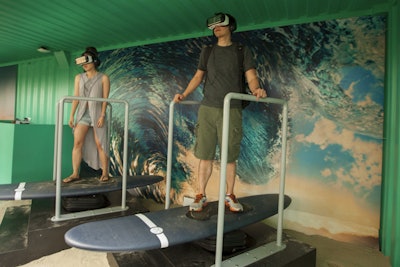
Guests could use VR devices to feel as though they were surfing in Tahiti (pictured) or skateboarding in Malibu. They could also participate in an experience that simulated a roller-coaster ride. Throughout the weekend, guests could also purchase Samsung products that were exclusively available at Lollapalooza.
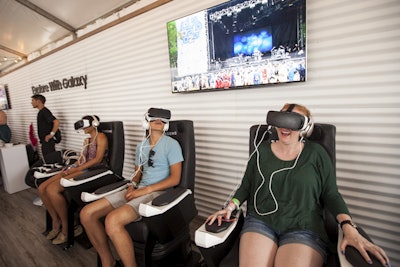
Each day, Samsung device owners had the chance to win passes to the Samsung Galaxy Lounge. In the hilltop lounge, guests could watch performances using virtual reality devices. The devices made users feel as though they were standing on stage with performers such as the Red Hot Chili Peppers.
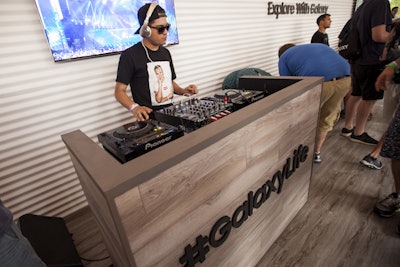
The lounge, which held about 400 people at a time, also had daily DJ performances. The DJs spun at a booth that was decked with the hashtag #GalaxyLife.
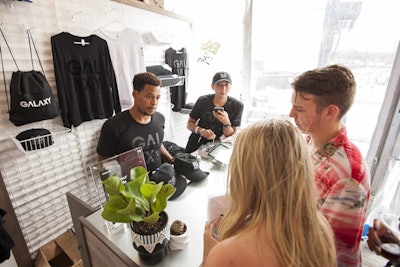
Guests at the lounge could pick up free Samsung merchandise. Gear included T-shirts, hats, and backpacks.
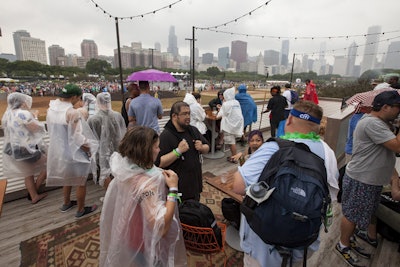
Swag also included ponchos with the Samsung logo. The ponchos proved particularly popular during Thursday and Friday's rainstorms. On the deck of the lounge, guests could look out directly onto the Samsung stage. New this year, device owners also had access to a special Samsung Owners' Lounge, which was a fenced-off area directly in front of the stage.
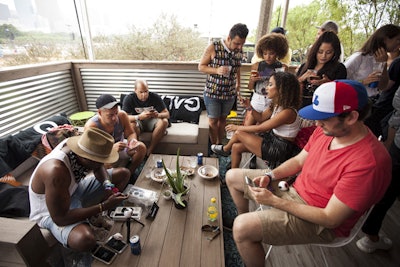
Along with premium stage views and the opportunity to check out new merchandise, the lounge gave Samsung customers creature comforts like cushy seating, snacks, drinks, and private restrooms.
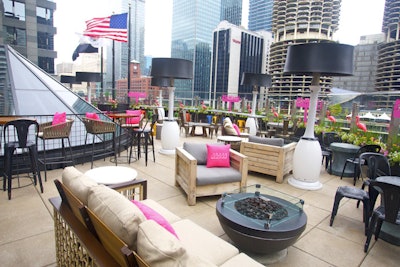
On Saturday, the Greater Miami Convention & Visitors Bureau invited artists, media, and V.I.P. guests to an off-site brunch at the "It's So Miami Lounge." The activation took over Raised, a new, rooftop bar at Renaissance Chicago Downtown Hotel. Bright-pink pillows with Miami branding decked the furniture, while plastic flamingos spruced up the flower boxes. BMF Media produced the event.
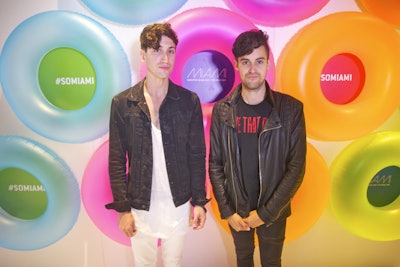
The brunch, held within walking distance of Grant Park, fueled guests with mimosas and snacks such as sliders and fries. There was also a photo opportunity in front of a wall of colored lifesavers, as well as a braid bar, cabanas to lounge in, and live acoustic sets from Lollapalooza acts including the Secret Weapons (pictured). Apart from daytime parties, there were several late-night events officially or unofficially related to the festival. There were 70 official "after-shows" featuring Lollapalooza talent at venues throughout the city. There were also late-night bashes with DJ sets and surprise performances at spots such as Soho House Chicago and Virgin Hotels Chicago.
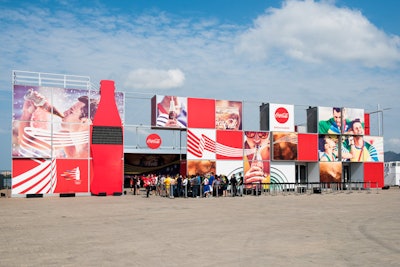
The brand's Olympic Park activation included a pin trading and retail experience, photo ops with the Olympic torch, and highlights of the brand's longstanding partnership with the Games.
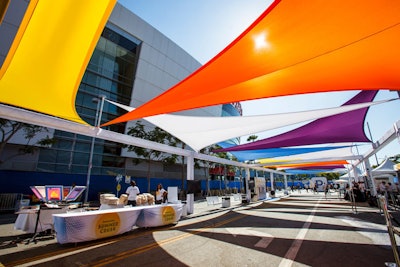
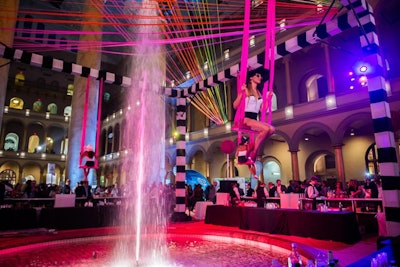
#2 Literary & Publishing Event
Held June 9 at the National Building Museum, the annual party from The Washingtonian celebrates the magazine's top choices for the best cuisine in Washington. More than 75 local restaurants participated in the event, which attracted 2,000 people. AT&T was the event's presenting sponsor at the event, which benefits the Leukemia & Lymphoma Society. Next: June 2017


















